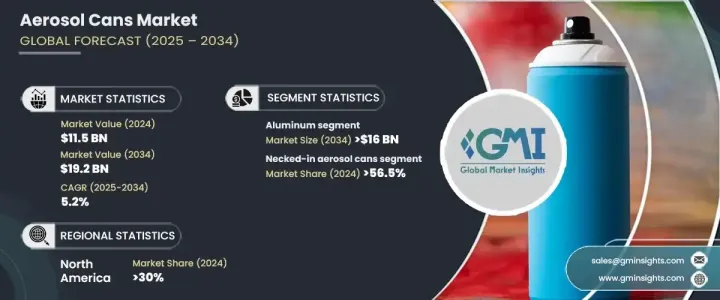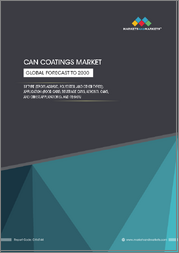
|
시장보고서
상품코드
1685226
에어로졸 캔 시장 : 시장 기회, 성장 촉진요인, 산업 동향 분석, 예측(2025-2034년)Aerosol Cans Market Opportunity, Growth Drivers, Industry Trend Analysis, and Forecast 2025 - 2034 |
||||||
세계의 에어로졸 캔 시장은 2024년에 115억 달러에 이르렀고, 2025-2034년 연평균 복합 성장률(CAGR) 5.2%로 성장할 것으로 예상되며 대폭적인 확대가 전망됩니다.
이러한 상승 궤도는 퍼스널케어, 가정용품, 의약품 및 식품을 비롯한 여러 산업에 걸쳐 편리하고 지속 가능한 패키징 솔루션에 대한 수요가 증가하고 있음을 뒷받침하고 있습니다. 에어로졸 캔은 제품 보존 기간의 연장, 사용의 용이성, 휴대성의 향상 등 수많은 이점을 제공해, 제조업체에도 소비자에게도 선호되는 옵션이 되고 있습니다. 또한, 밀폐성은 오염을 방지하고 제품의 무결성을 보장하기 때문에 의약품 및 화장품과 같은 섬세한 용도에서 특히 중요합니다.

환경에 대한 관심이 소비자의 선호와 업계의 규제를 계속 형성하고 있기 때문에 제조업체는 환경에 미치는 영향을 최소화하는 혁신적인 소재 및 설계에 투자하고 있습니다. 재활용 가능한 소재와 생분해성이 높은 소재가 중시되어 기업은 지속 가능한 생산방법으로 향하고 있습니다. 브랜드는 내구성과 기능성을 유지하면서 운송시 이산화탄소 배출량을 줄이는 경량 에어로졸 캔을 채용하고 있습니다. 또한 압축 공기 및 질소와 같은 환경 친화적인 대체물의 사용을 포함한 추진제 기술의 진보는 시장 지속가능성에 대한 노력을 강화하고 있습니다. 이러한 요인은 종합적으로 시장의 꾸준한 확대에 기여하고 에어로졸 캔을 현대에 필수적인 패키징 솔루션으로 자리매김하고 있습니다.
| 시장 범위 | |
|---|---|
| 시작 연도 | 2024년 |
| 예측 연도 | 2025-2034년 |
| 시작 금액 | 115억 달러 |
| 예측 금액 | 192억 달러 |
| CAGR | 5.2% |
에어로졸 캔 시장은 소재의 유형에 따라 알루미늄, 스틸, 플라스틱으로 구분됩니다. 알루미늄 부문은 CAGR 5.5%를 기록하며 2034년까지 160억 달러를 창출할 것으로 예상됩니다. 알루미늄 에어로졸 캔은 경량 설계, 우수한 내식성, 우수한 재활용성으로 인기를 끌고 있습니다. 이러한 특성으로 인해 알루미늄은 지속 가능한 패키징으로 선호되며 환경 책임을 선호하는 산업에 대응합니다. 개인 관리, 의약품 및 식품에 널리 사용되는 알루미늄 에어로졸 캔은 오염 위험을 최소화하면서 제품의 무결성을 유지합니다. 또한, 고급 및 환경 친화적인 패키징에 대한 소비자의 선호도 증가는 알루미늄 기반 에어로졸 솔루션 수요를 계속 추진하고 있습니다.
에어로졸 캔 시장은 또한 straight-wall 에어로졸 캔, shaped 에어로졸 캔, necked-in 에어로졸 캔 등을 포함한 제품 유형별로 분류됩니다. necked-in 에어로졸 캔은 2024년에 56.5%의 점유율로 시장을 독점했습니다. 효율적인 디자인은 스택과 운송 능력을 향상시켜 고압 용도를 지원하면서 물류 비용을 대폭 절감합니다. 이 때문에 퍼스널케어, 가정용품, 공업 제품에 이상적인 선택이 되고 있습니다. 또한 경량 구조는 성능을 저하시키지 않으면서 내구성을 확보하고 비용 효율적이며 자원 효율적인 패키징 솔루션에 대한 요구가 높아졌습니다.
북미는 2024년에 에어로졸 캔 시장의 30%의 점유율을 차지해, 퍼스널케어 및 가정용 세정 제품 분야에서의 왕성한 수요에 견인되었습니다. 이 지역은 지속 가능한 패키징 솔루션에 주력하고 있으며, 엄격한 환경 규제에 맞게 소재와 낮은 VOC 처방의 진보를 가속화하고 있습니다. 또한 자동차, 의약품, 식품업계에서는 편리하고 고급스러운 포장을 선호하는 소비자가 늘어나 시장의 발판을 굳히고 있습니다. 재활용률이 높고 환경 친화적인 패키징 솔루션에 대한 의식이 높아짐에 따라 북미는 세계 에어로졸 캔 업계의 주요 기업으로 자리매김하여 시장 성장을 가속하고 있습니다.
목차
제1장 조사 방법 및 조사 범위
- 시장 범위 및 정의
- 기본 추정 및 계산
- 예측 계산
- 데이터 소스
제2장 주요 요약
제3장 업계 인사이트
- 생태계 분석
- 밸류체인에 영향을 주는 요인
- 혁신
- 장래 전망
- 제조업체
- 유통업체
- 이익률 분석
- 주요 뉴스 및 대처
- 규제 상황
- 영향요인
- 성장 촉진요인
- 퍼스널케어 제품 수요 증가
- 가정용 제품에서 채용 증가
- 의약품 및 헬스케어 분야에서 사용 증가
- 산업용 및 자동차용 용도의 확대
- 전자상거래 분야 확대
- 업계의 잠재적 위험 및 과제
- VOC 배출에 관한 환경 문제
- 높은 원료 비용
- 성장 촉진요인
- 성장 가능성 분석
- Porter's Five Forces 분석
- PESTEL 분석
제4장 경쟁 구도
- 서문
- 기업 점유율 분석
- 경쟁 포지셔닝 매트릭스
- 전략 전망 매트릭스
제5장 시장 추계 및 예측 : 재료 유형별(2021-2034년)
- 주요 동향
- 알루미늄
- 스틸
- 플라스틱
제6장 시장 추계 및 예측 : 제품 유형별(2021-2034년)
- 주요 동향
- straight-wall 에어로졸 캔
- necked-in 에어로졸 캔
- shaped 에어로졸 캔
- 기타
제7장 시장 추계 및 예측 : 프로펠런트 유형별(2021-2034년)
- 주요 동향
- 액화 가스 추진제
- 압축 가스 추진제
제8장 시장 추계 및 예측 : 사이즈별(2021-2034년)
- 주요 동향
- 소형(3온스 미만)
- 중형(3온스-8온스)
- 대형(8온스 이상)
제9장 시장 추계 및 예측 : 용도별(2021-2034년)
- 주요 동향
- 퍼스널케어 및 화장품
- 향수 및 향기
- 헤어 케어 제품
- 스킨케어 및 선스크린
- 기타
- 스프레이
- 윤활제 및 그리스
- 접착제 및 씰링제
- 가정용 제품
- 방향제
- 살충제 및 구충제
- 기타
- 페인트 및 코팅제
- 기타
제10장 시장 추계 및 예측 : 지역별(2021-2034년)
- 주요 동향
- 북미
- 미국
- 캐나다
- 유럽
- 영국
- 독일
- 프랑스
- 이탈리아
- 스페인
- 러시아
- 아시아태평양
- 중국
- 인도
- 일본
- 한국
- 호주
- 라틴아메리카
- 브라질
- 멕시코
- 중동 및 아프리카
- 남아프리카
- 사우디아라비아
- 아랍에미리트(UAE)
제11장 기업 프로파일
- Aeropack
- Ball
- Canpack
- Casablanca Industries
- CCL Industries
- Colep Portugal
- Crown Holdings
- Favor
- Graham Packaging
- Henkel
- Linhardt
- Mauser(Bway Corporation)
- MJS Packaging
- Montebello Packaging
- Nampak
- Perfektup
- Trivium Packaging
- Tubex
The Global Aerosol Cans Market reached USD 11.5 billion in 2024 and is set for significant expansion, projected to grow at a CAGR of 5.2% between 2025 and 2034. This upward trajectory is fueled by the increasing demand for convenient and sustainable packaging solutions across multiple industries, including personal care, household, pharmaceuticals, and food. Aerosol cans offer numerous advantages, such as extended product shelf life, ease of use, and enhanced portability, making them a preferred choice for manufacturers and consumers alike. Additionally, their airtight sealing prevents contamination and ensures product integrity, which is particularly important in sensitive applications like pharmaceuticals and cosmetics.

As environmental concerns continue to shape consumer preferences and industry regulations, manufacturers are investing in innovative materials and designs that minimize environmental impact. The rising emphasis on recyclable and biodegradable materials is pushing companies toward sustainable production methods. Brands are increasingly adopting lightweight aerosol cans that reduce carbon emissions during transportation while maintaining durability and functionality. Furthermore, advancements in propellant technologies, including the use of eco-friendly alternatives such as compressed air and nitrogen, are reinforcing the market's commitment to sustainability. These factors collectively contribute to the market's steady expansion, positioning aerosol cans as a vital packaging solution for the modern era.
| Market Scope | |
|---|---|
| Start Year | 2024 |
| Forecast Year | 2025-2034 |
| Start Value | $11.5 Billion |
| Forecast Value | $19.2 Billion |
| CAGR | 5.2% |
Based on material type, the aerosol cans market is segmented into aluminum, steel, and plastic. The aluminum segment is expected to witness a CAGR of 5.5%, generating USD 16 billion by 2034. Aluminum aerosol cans are gaining traction due to their lightweight design, superior corrosion resistance, and exceptional recyclability. These attributes make aluminum a preferred choice for sustainable packaging, catering to industries that prioritize environmental responsibility. Widely used in personal care, pharmaceuticals, and food, aluminum aerosol cans preserve product integrity while minimizing contamination risks. Additionally, increasing consumer preference for premium and eco-friendly packaging continues to fuel demand for aluminum-based aerosol solutions.
The aerosol cans market is further categorized by product type, including straight-wall aerosol cans, shaped aerosol cans, necked-in aerosol cans, and others. Necked-in aerosol cans dominated the market with a 56.5% share in 2024. Their efficient design enhances stacking and transportation capabilities, significantly reducing logistics costs while supporting high-pressure applications. This makes them an ideal choice for personal care, household, and industrial products. Furthermore, their lightweight structure ensures durability without compromising performance, aligning with the growing need for cost-effective, resource-efficient packaging solutions.
North America held a commanding 30% share of the aerosol cans market in 2024, driven by strong demand in personal care and household cleaning product sectors. The region's focus on sustainable packaging solutions has accelerated advancements in materials and low-VOC formulations, aligning with stringent environmental regulations. Additionally, growing consumer preference for convenient and premium packaging in the automotive, pharmaceutical, and food industries strengthens the market's foothold. High recycling rates and increased awareness about eco-friendly packaging solutions continue to propel market growth, positioning North America as a key player in the global aerosol cans industry.
Table of Contents
Chapter 1 Methodology & Scope
- 1.1 Market scope & definitions
- 1.2 Base estimates & calculations
- 1.3 Forecast calculations
- 1.4 Data sources
- 1.4.1 Primary
- 1.4.2 Secondary
- 1.4.2.1 Paid sources
- 1.4.2.2 Public sources
Chapter 2 Executive Summary
- 2.1 Industry synopsis, 2021-2034
Chapter 3 Industry Insights
- 3.1 Industry ecosystem analysis
- 3.1.1 Factor affecting the value chain
- 3.1.2 Disruptions
- 3.1.3 Future outlook
- 3.1.4 Manufacturers
- 3.1.5 Distributors
- 3.2 Profit margin analysis
- 3.3 Key news & initiatives
- 3.4 Regulatory landscape
- 3.5 Impact forces
- 3.5.1 Growth drivers
- 3.5.1.1 Growing demand for personal care products
- 3.5.1.2 Rising adoption in household products
- 3.5.1.3 Increasing use in pharmaceuticals and healthcare
- 3.5.1.4 Expansion of industrial and automotive applications
- 3.5.1.5 Expansion of the e-commerce sector
- 3.5.2 Industry pitfalls & challenges
- 3.5.2.1 Environmental concerns over VOC emissions
- 3.5.2.2 High raw material costs
- 3.5.1 Growth drivers
- 3.6 Growth potential analysis
- 3.7 Porter’s analysis
- 3.8 PESTEL analysis
Chapter 4 Competitive Landscape, 2024
- 4.1 Introduction
- 4.2 Company market share analysis
- 4.3 Competitive positioning matrix
- 4.4 Strategic outlook matrix
Chapter 5 Market Estimates & Forecast, By Material Type, 2021-2034 (USD Billion & Units)
- 5.1 Key trends
- 5.2 Aluminum
- 5.3 Steel
- 5.4 Plastic
Chapter 6 Market Estimates & Forecast, By Product Type, 2021-2034 (USD Billion & Units)
- 6.1 Key trends
- 6.2 Straight wall aerosol cans
- 6.3 Necked-in aerosol cans
- 6.4 Shaped aerosol cans
- 6.5 Others
Chapter 7 Market Estimates & Forecast, By Propellant Types, 2021-2034 (USD Billion & Units)
- 7.1 Key trends
- 7.2 Liquefied gas propellants
- 7.3 Compressed gas propellants
Chapter 8 Market Estimates & Forecast, By Size, 2021-2034 (USD Billion & Units)
- 8.1 Key trends
- 8.2 Small (less than 3 oz)
- 8.3 Medium (3 oz - 8 oz)
- 8.4 Large (more than 8 oz)
Chapter 9 Market Estimates & Forecast, By Application, 2021-2034 (USD Billion & Units)
- 9.1 Key trends
- 9.2 Personal care and cosmetics
- 9.2.1 Perfumes & fragrances
- 9.2.2 Hair care products
- 9.2.3 Skin care & sunscreens
- 9.2.4 Others
- 9.3 Topical sprays
- 9.4 Lubricants & greases
- 9.5 Adhesives & sealants
- 9.6 Household products
- 9.6.1 Air fresheners
- 9.6.2 Insecticides & pesticides
- 9.6.3 Others
- 9.7 Paints and coatings
- 9.8 Others
Chapter 10 Market Estimates & Forecast, By Region, 2021-2034 (USD Billion & Units)
- 10.1 Key trends
- 10.2 North America
- 10.2.1 U.S.
- 10.2.2 Canada
- 10.3 Europe
- 10.3.1 UK
- 10.3.2 Germany
- 10.3.3 France
- 10.3.4 Italy
- 10.3.5 Spain
- 10.3.6 Russia
- 10.4 Asia Pacific
- 10.4.1 China
- 10.4.2 India
- 10.4.3 Japan
- 10.4.4 South Korea
- 10.4.5 Australia
- 10.5 Latin America
- 10.5.1 Brazil
- 10.5.2 Mexico
- 10.6 MEA
- 10.6.1 South Africa
- 10.6.2 Saudi Arabia
- 10.6.3 UAE
Chapter 11 Company Profiles
- 11.1 Aeropack
- 11.2 Ball
- 11.3 Canpack
- 11.4 Casablanca Industries
- 11.5 CCL Industries
- 11.6 Colep Portugal
- 11.7 Crown Holdings
- 11.8 Favor
- 11.9 Graham Packaging
- 11.10 Henkel
- 11.11 Linhardt
- 11.12 Mauser (Bway Corporation)
- 11.13 MJS Packaging
- 11.14 Montebello Packaging
- 11.15 Nampak
- 11.16 Perfektup
- 11.17 Trivium Packaging
- 11.18 Tubex



















